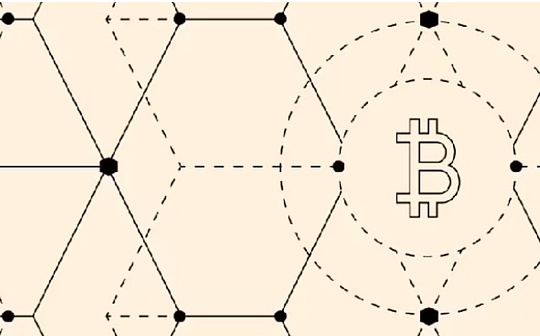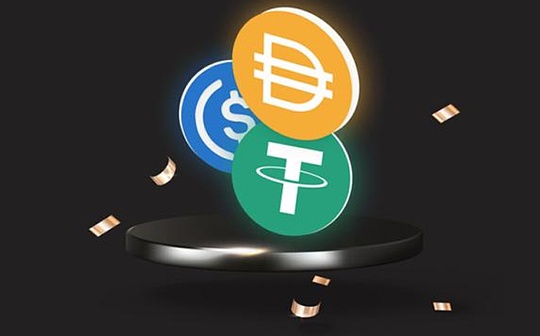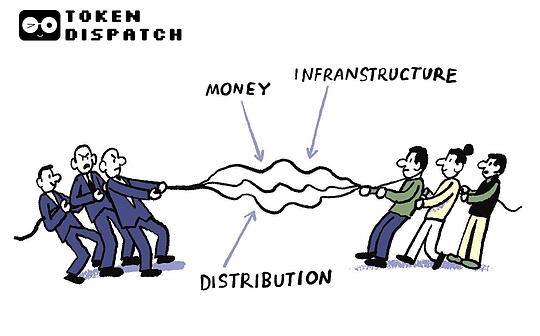
Author: Kate Li and Maria Shen, Electric Capital; Compiled by: Bitcoin Vision
executive summary
We analyzed three months of transaction data from wallets holding stablecoins on the five largest stablecoin networks: Ethereum, Base, BSC, Tron, and Solana—these networks processed $13.59 trillion in transaction volume between July and September 2025.By mapping when these wallets holding stablecoins are active, we can infer where users are located around the world.
The use of stablecoins is truly global, but it is not evenly distributed.Three clear patterns emerge from the data:
1. The activity in the Americas is unusually high.Although the Americas account for a smaller share of the global population, stablecoin transaction volume generated by users in the Western Hemisphere rivals or even exceeds that of far more densely populated regions.This shows that stablecoins have huge room for growth in other parts of the world, especially in high-population-density areas where adoption rates are still relatively low.
2. Different chains serve different geographical areas.BSC and Tron are highly concentrated in Asian, Middle Eastern, and African markets, with very low activity during Western business hours (<3%).Ethereum, Solana, and Base show wider geographic coverage than BSC and Tron, with active users spread across multiple time zones.
3. There are differences in the geographical distribution of large-value wallets and small-value wallets on different chains..Base and Solana show a clear divide, with large wallets (probably institutions) concentrated in Western financial centers, while small wallets (probably retail users) are distributed globally.In contrast, BSC, Tron, and Ethereum show a convergence in the geographical distribution of wallets of different sizes, indicating that their user bases are more geographically unified.
Important notes:
Wallet is not equal to person
Each wallet represents an address, not a person.If different regions have different numbers of wallets per capita, the geographic distribution of the population may differ.This analysis assumes that the global per capita wallet ownership is evenly distributed.
Geographic inference is based on typical working hours
We infer a wallet’s location based on its activity between 9am and 5pm local time.However, the regional mapping may change if stablecoin users in certain regions tend to trade outside of these time periods.While stablecoin activity does occur across all time periods, this analysis assumes that early risers and night owls are roughly evenly distributed across the globe, so this 9am to 5pm framework is directionally valid in identifying areas of major activity.
Our full methodology is found at the end of this article.
Stablecoin usage is global, but activity is unusually high in the West
We first aggregate and analyze activity across all five chains to identify broad patterns in global stablecoin usage.
Stablecoin activity shows two different peaks in different regional centers
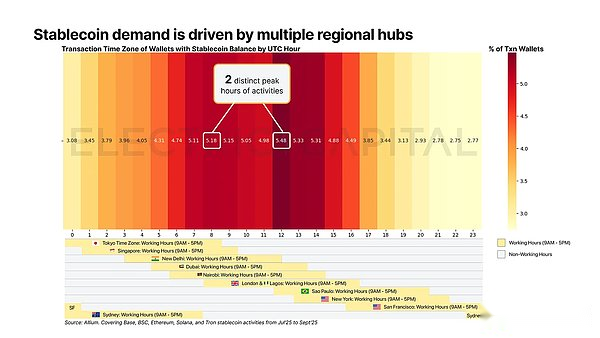
Stablecoin activity is not limited to a single geographic region.Instead, its use is spread across time zones, with two distinct peaks:
8:00 UTC – when working hours overlap in Asia, the Middle East, Africa and parts of Europe
12:00 UTC — When working hours overlap in the Middle East, Africa, Europe, and Latin America (US East Coast joins at 13:00 UTC)
This double-peak pattern suggests that stablecoin demand is driven by a combination of several regional centers, rather than being dominated by a single geographic region.
But the Western Hemisphere’s influence exceeds its population weight
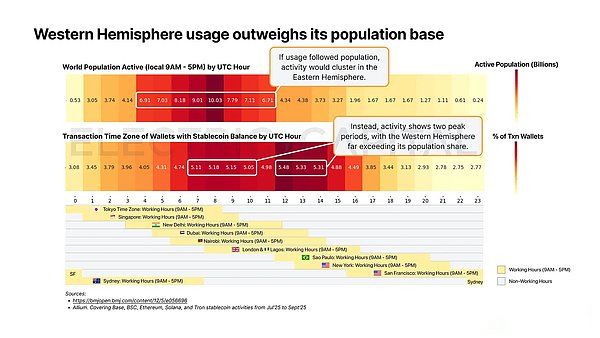
If stablecoin adoption followed population distribution at all, activity would be highly concentrated in the Eastern Hemisphere (UTC 4–11), as the majority of the world’s population lives there (as shown in the chart above).
However, the peak at 12:00 UTC reveals the disproportionate influence of the Western Hemisphere: despite a smaller population base, the Americas generate more stablecoin activity than more densely populated regions.
Large-value wallets are concentrated in financial centers, while small-value wallets are distributed globally
We now segment wallets by stablecoin balance to see if different types of users behave differently.As of October 1, 2025, approximately 0.3% of wallets held more than $100,000, while 80.4% held between $1 and $100.These groups show different geographic patterns.
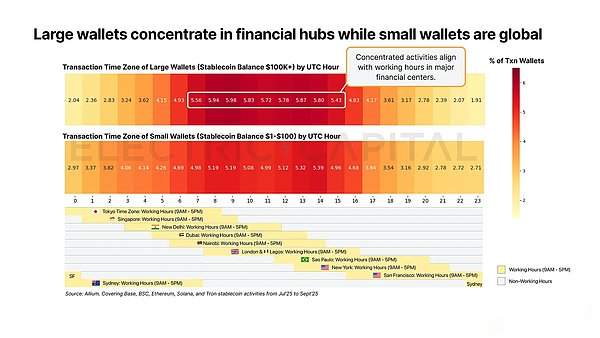
Large wallets cluster around traditional financial centers
Activity from large wallets ($100,000+) is concentrated between 07:00 and 15:00 UTC, which coincides with business hours in Asia, the Middle East, Europe, and the East Coast of the United States.This pattern suggests that institutional or professional users operate primarily during the business hours of major financial centers.
Small wallets show wider global adoption
Small value wallets ($1 to $100) show broader activity across all time zones, without the sharp drop in concentration seen with larger value wallets.This distribution shows that daily users are transacting throughout the day in different geographical areas.
BSC and Tron remain anchored in the Eastern Hemisphere, while Ethereum, Solana, and Base have global reach
Next, we break down stablecoin activity by chain to see if different networks serve different parts of the world.The answer is: some chains have achieved global distribution, while other chains are still concentrated in specific regions.
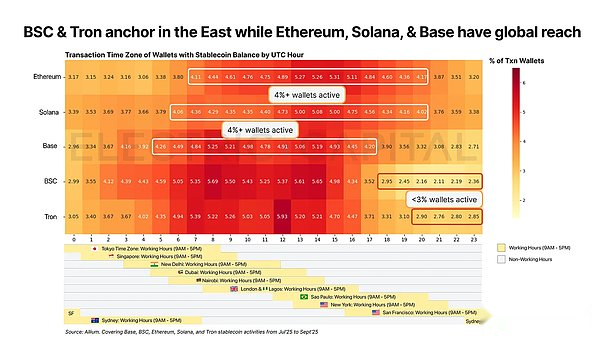
Ethereum and Solana demonstrate balanced global usage
Ethereum and Solana activity is spread across both hemispheres, with strong participation during both Eastern (UTC 7–11) and Western Hemisphere (UTC 13–16) business hours.These chains have successfully penetrated global markets.
BSC and Tron anchored in Asia, Middle East and Africa
BSC and Tron show strikingly similar patterns, with activity concentrated between 06:00 and 15:00 UTC – which coincides with working hours in Asia, the Middle East, and Europe.Although both chains have large total user bases, the share of activity during the US session is less than 3%, indicating extremely low relative adoption in the West.
Base shows emerging global influence
Base exhibits more geographic diversity than BSC or Tron, with significant activity across multiple time zones.While not yet reaching the global balance of Ethereum or Solana, Base is showing strength in the Western Hemisphere while growing adoption in other regions.
On different chains, large wallets and small wallets are aggregated in different ways.
Breaking down activity by chain and wallet size reveals distinct patterns.Large wallets (which may represent institutional or professional users) versus small wallets (which may represent retail users) show different geographic concentration.However, these patterns vary from chain to chain.
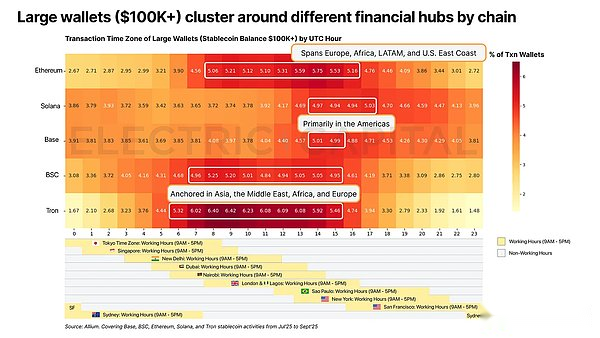
Large value wallets ($100,000+) cluster around different financial centers on different chains
Ethereum: Concentrated between 8:00 and 16:00 UTC, spanning Europe, Africa, Latin America, and the US East Coast – the most geographically diverse of the major chains.
Solana and Base: Mainly active in the Americas, with peaks starting at approximately 13:00 UTC, when US and Latin American markets begin trading.
BSC: Clustered between 07:00 and 15:00 UTC, consistent with working hours in Asia, the Middle East, Africa, and Europe, with minimal US activity.
Tron: The most regionally concentrated, active between 6:00 and 16:00 UTC, anchored in Asia, the Middle East and Africa.
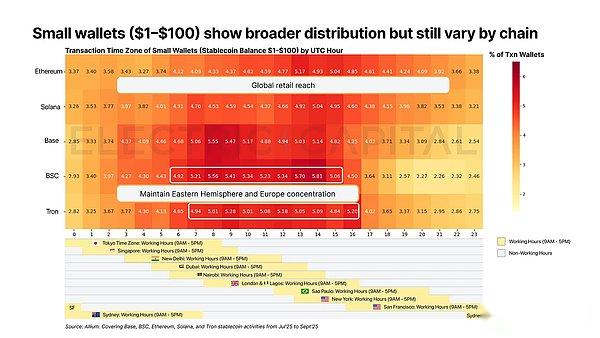
Small value wallets ($1–100) are more widely distributed but still vary from chain to chain
Ethereum and Solana: Demonstrate global retail reach, with strong participation in the Americas and other regions.
BSC and Tron: Maintaining concentration in the Eastern Hemisphere and Europe, indicating that retail adoption follows the same geographic pattern as large wallets.
Base: Shows retail strength in the Eastern Hemisphere while participation is on the rise in the Western Hemisphere.
In-depth analysis: stablecoin activity patterns of each chain
We now examine each chain one by one, breaking down activity by wallet size to understand where different types of users operate on each network.
Ethereum
Ethereum maintains global distribution, but its Western usage is unusually strong relative to the region’s population share.
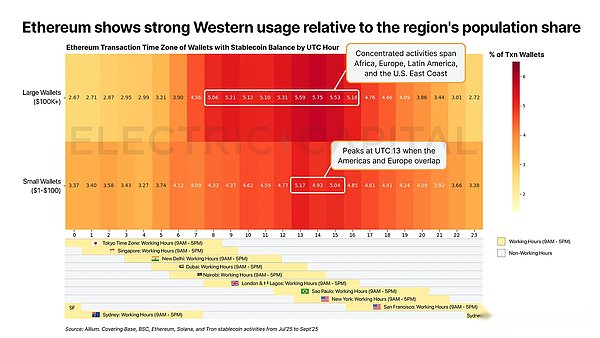
Large wallets ($100,000+): Activity is concentrated between 0800 and 1600 UTC, with peak participation across Africa, Europe, Latin America, and the US East Coast.
Small wallets ($1–100): Activity peaks at 13:00 UTC, when American and European times overlap.Although the Western Hemisphere has a smaller population, its per capita usage significantly exceeds that of other regions.
Ethereum’s user base spans the globe, but Western users—both large and small wallets—are unusually highly engaged relative to their share of the population.
Solana
Solana shows a geographical separation between large and small wallets: large funds are concentrated in the Americas, while small wallet users are distributed globally.
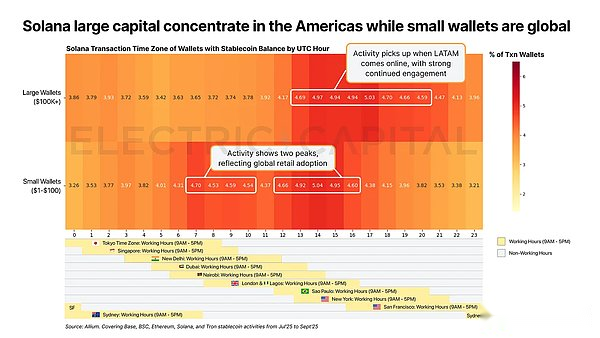
Large wallets ($100,000+): Activity begins at 13:00 UTC, when trading begins on the US East Coast and Latin America, and continues with strong participation until 16:00 UTC.The U.S. West Coast has the highest per capita usage of any region in the world.
Small wallets ($1–100): Activity shows two peaks at 7–10 UTC (Asia/Middle East/Africa/Europe overlap) and 12–16 UTC (Europe/Latin America/North America overlap), reflecting global retail adoption.
There is a clear institutional-retail geographic divide at Solana: large wallets cluster in Western financial centers, while small wallets trade across all time zones.
Base
Base The sharpest geographic divide exists between large and small wallets: small wallets are skewed east, while large wallets are skewed west, and large wallets have a wider spread of activity than small wallets.
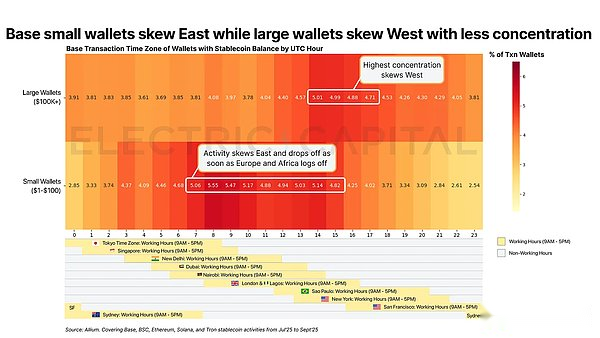
Large wallets: The most concentrated period is 14:00 UTC, when Europe, Africa, Latin America and the US East Coast time overlap.
Small Wallet: Following the general cross-chain trend, but leaning more heavily towards the east.Once European and African users went offline, usage dropped dramatically.
BSC
BSC is anchored to users in the Eastern Hemisphere and has limited influence during the U.S. time period.
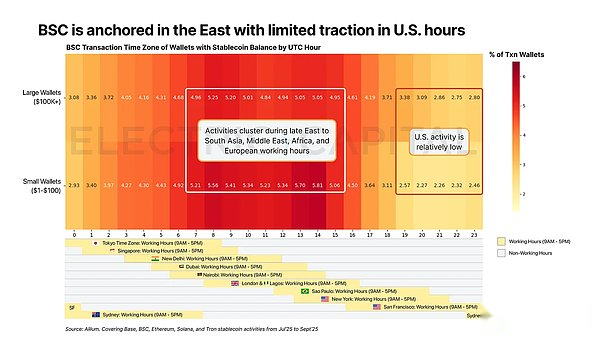
Large and small wallets: Both cluster between 07:00 and 15:00 UTC, covering business hours from the Far East to South Asia, the Middle East, Africa and Europe.Peaks occur at 8:00 UTC (London open) and 13:00 UTC (US East Coast open).
Regional bias: US activity is relatively low after 15:00 UTC, while Asia shows a stronger presence (from about 2:00 UTC).
Tron
Tron usage is highly regionally anchored, especially for large wallets.
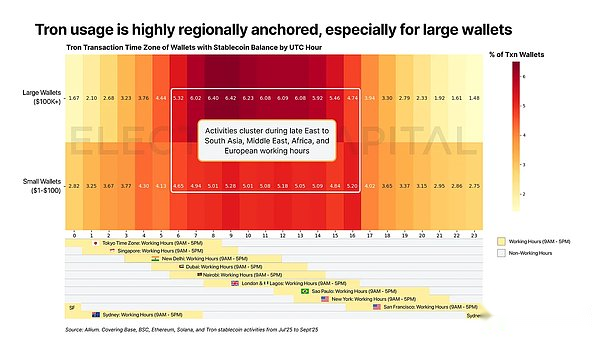
Large and small value wallets: Both show a strong concentration between 06:00 and 16:00 UTC, consistent with working hours from the Far East to South Asia, the Middle East, Africa, and Europe.
Tron has the highest concentration of large wallet activity of any chain.
Scope and methodology
chain: Ethereum, Base, BSC, Tron, Solana
time period: July to September 2025
transaction type: The analysis covers transfer transactions involving 33 major fiat-backed and non-fiat-backed stablecoins, includingUSDT, USDC, USDe, DAI, USDS, FDUSD, USD₀, crvUSD, FRAX, USDX, USR, USDZ, TUSD, PYUSD, BUSD, MIM, M, EURC, XSGD, USDP, DEUSD, USDG, USDD, GHO, DOLA, USDA, GYEN, GUSD, EURS, USDM and RLUSD.
A small number of known contracts or test addresses are excluded to remove noise and ensure that only real wallet activity is counted.
wallet filter: We use each wallet’s stablecoin balance at the beginning of the month as a proxy for its size.Wallets with a balance below $1 at the beginning of the month were excluded from the analysis for that month.
methodology:
To measure when users are most active, we count the number of occurrences for each active hour per wallet on a monthly basis.
If a wallet makes multiple transfers during the same UTC hour in two out of three months, it is counted twice.
If a wallet makes multiple transfers during the same hour within the same month, it is only counted once for that month.
When aggregating cross-chain activity (e.g., all wallets or large vs. small wallets), we remove duplicates across EVM-compatible networks (Ethereum, Base, BSC, and Tron) to ensure each wallet is only counted once.

